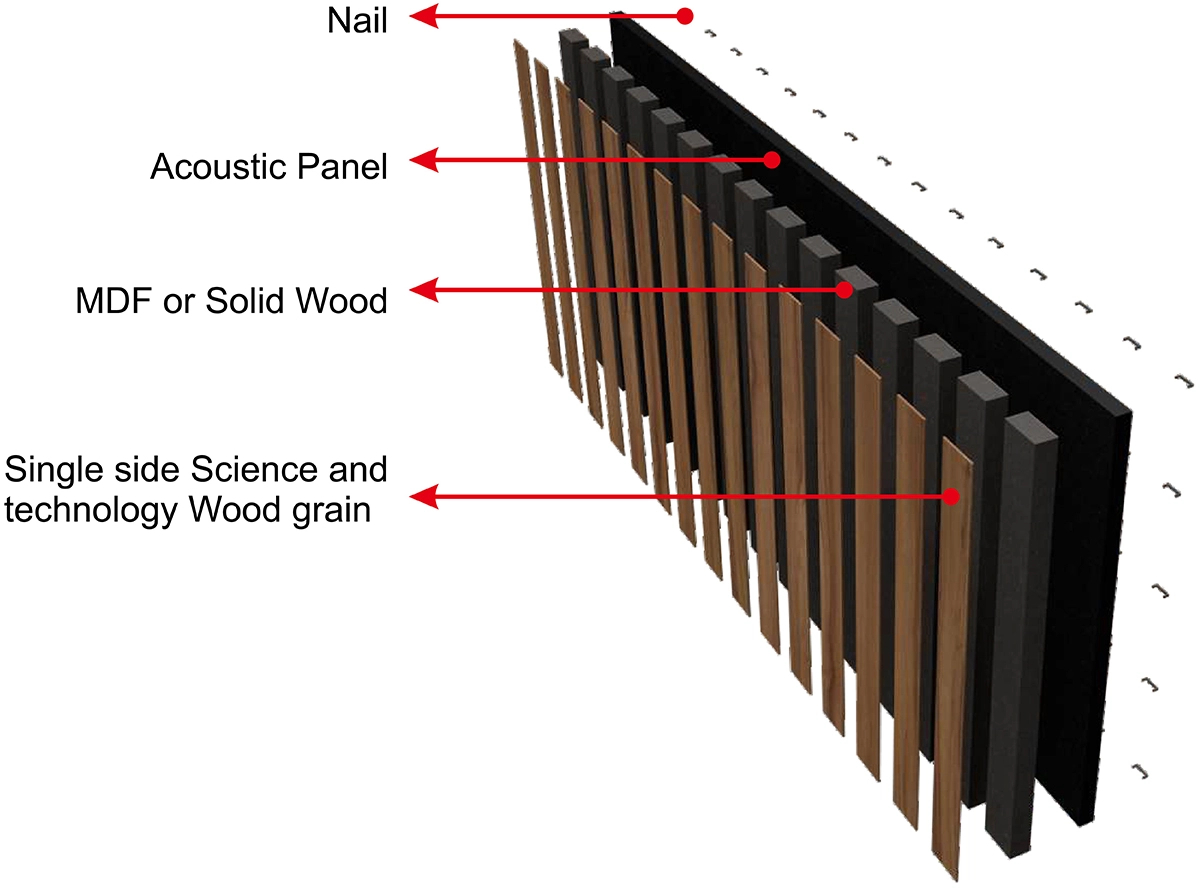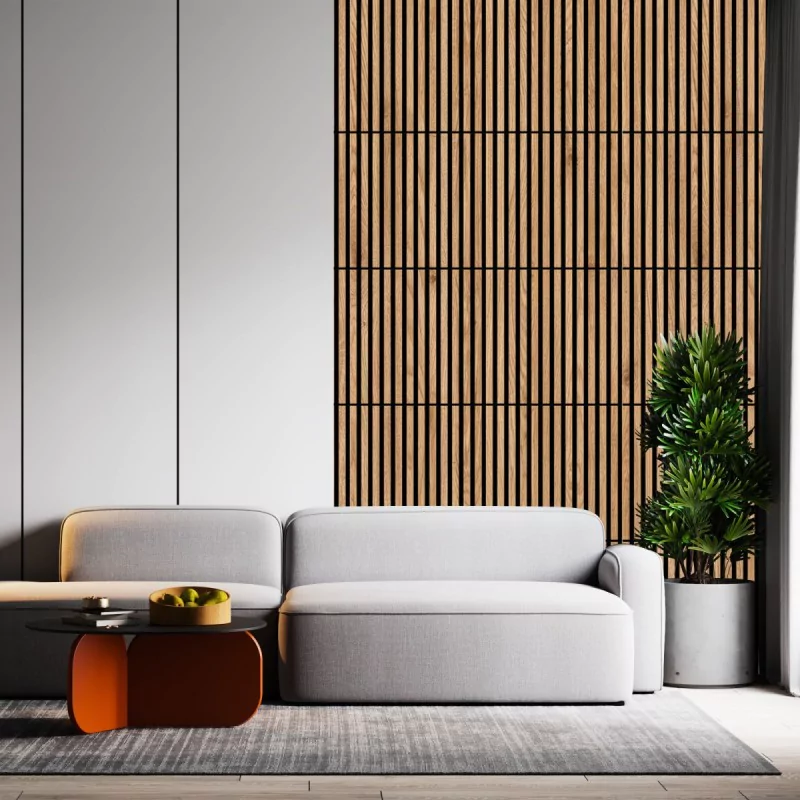Imagine the perfect sound propagation while watching your favourite concert in your home theater. Imagine that during a short conversation you don’t have to ask for the last sentence to be repeated several times. This is what acoustic panels will help you with. This tasteful addition will not only warm up the interior and give it a modern feel, but at the same time it will solve the need for soundproofing the walls and increase the acoustic comfort experience on a daily basis.
Do you want to find out why it is worth opting for acoustic panels? Read the following article, in which we will show you the benefits of this solution step by step.

What Are Acoustic Panels?
Acoustic panels slats are made of high-quality board covered with water-resistant veneer. Their wood-like 3D structure will make them look great on your wall for a long time.
In addition to being a tasteful addition to interiors and often chosen as an elegant, character-enhancing accessory , it is also a very practical solution. They can, for example, effectively demarcate zones in a room and additionally make the space feel cosy.
The acoustic panels warm the interior perfectly, making it comfortable and relaxing to be in. For this reason, it is a frequent choice for flats, homes and offices, but also public spaces such as restaurants and hotels.
For some, aesthetic issues will be the most important, for others it will be the details of the technical specifications. The acoustic panels have thermal insulation properties and, depending on the material used, can improve acoustic adaptation in the room.
What Are The Acoustic Panels’ Advantages?
1. Enhanced Sound Quality
One of the primary functions of acoustic panels is to improve the sound quality within a space. In environments where clear communication is critical—such as conference centers, classrooms, or call centers—acoustic panels absorb unwanted sound waves and minimize echo. This results in a clearer and more intelligible audio experience, ensuring that speech and presentations are easily understood.
2. Noise Reduction and Soundproofing
Acoustic panels help reduce ambient noise, making them an essential addition to offices, restaurants, healthcare facilities, and manufacturing plants. By absorbing excess sound, these panels create quieter environments that can lead to improved focus, lower stress levels, and better overall productivity. This noise reduction capability is particularly valuable in B2B applications where a controlled sound environment is necessary for operational efficiency and safety.
3. Versatility in Design
Modern acoustic panels come in a wide range of designs, colors, and materials, allowing businesses to choose products that not only serve functional purposes but also complement the aesthetic of their space. Whether you prefer a sleek, modern look or a more classic design, there’s an acoustic panel solution tailored to your needs. This versatility means that acoustic treatments can be seamlessly integrated into any interior design plan without compromising on style.

4. Improved Privacy
In spaces where confidentiality is essential—such as law offices, medical practices, and financial institutions—acoustic panels help reduce sound transmission between rooms. This enhanced privacy is critical for maintaining confidentiality and protecting sensitive information. By incorporating these panels into your design, you can create secure environments that foster trust and professionalism.
5. Energy Efficiency and Environmental Benefits
Many acoustic panels are made from sustainable materials and contribute to energy efficiency by reducing the need for additional HVAC noise control measures. Some panels are designed to regulate temperature and improve indoor air quality, providing an eco-friendly solution that aligns with corporate sustainability initiatives. Investing in green acoustic products can also bolster your business's reputation in the market as an environmentally responsible entity.
6. Boosted Productivity and Employee Satisfaction
A well-designed acoustic environment can significantly enhance employee satisfaction and productivity. Studies have shown that noise pollution is a major source of distraction and stress in modern workplaces. By installing acoustic panels, companies can create a quieter and more focused work environment, which leads to better employee performance, reduced stress levels, and overall improved well-being.

How To Select Acoustic Panels For The Interior?
The market offers a diverse array of acoustic panels, each with its unique features and benefits. Understanding the various types available will help you select the best solution for your specific needs.
1. Fabric-Wrapped Acoustic Panels
Fabric-wrapped panels are popular for their aesthetic appeal and excellent sound-absorbing properties. These panels consist of a high-density core material wrapped in decorative fabric. The fabric can be customized to match your brand's color scheme, making these panels an ideal choice for corporate environments, auditoriums, and hospitality venues. Their versatility in design and texture makes them a favorite among interior designers looking to combine functionality with style.
2. Foam Acoustic Panels
Foam panels are widely used in both professional studios and casual office environments. Typically made from polyurethane or melamine foam, these panels are lightweight and highly effective at absorbing mid to high-frequency sounds. They are easy to install and maintain, making them an attractive option for businesses on a tight budget. Due to their efficient sound absorption, foam panels are frequently deployed in educational institutions, gyms, and home offices.
3. Wood Acoustic Panels
Wood acoustic panels provide a natural and sophisticated look while delivering superior sound absorption. These panels are often used in high-end restaurants, upscale office spaces, and luxury hotels. Wood panels can be designed with various finishes, including matte, glossy, or textured surfaces, which add an extra dimension to the space’s overall design. They offer both aesthetic value and functional benefits by reducing noise levels and enhancing sound clarity.

4. Perforated Acoustic Panels
Perforated panels consist of a thin layer of material (often metal or wood) with a series of holes or slots, mounted over a sound-absorbing backing. This design not only reduces noise but also creates interesting visual patterns. Perforated panels are ideal for modern office settings, exhibition halls, and concert venues where both sound quality and visual impact are important. Their design flexibility allows them to be customized for various shapes and sizes, making them an adaptable solution for any project.
5. Suspended Ceiling Acoustic Panels
Suspended ceiling panels are integrated into the ceiling structure, offering a clean and unobtrusive solution to noise control. These panels are often found in commercial offices, retail spaces, and public buildings where ceiling aesthetics are as important as functionality. They are designed to blend seamlessly into the ceiling while providing robust sound absorption. Their installation process typically involves a grid system, making them easy to remove for maintenance or replacement.
6. Custom Acoustic Panels
For businesses with unique acoustic challenges or design requirements, custom acoustic panels are the ideal solution. Custom panels can be engineered to meet specific sound absorption criteria while incorporating unique design elements. They are perfect for spaces that require specialized acoustics, such as recording studios, broadcast facilities, and performance venues. The customization process allows for tailored dimensions, materials, and finishes, ensuring that the final product perfectly aligns with both performance and aesthetic goals.

How To Install Acoustic Panels
Proper installation is crucial to maximizing the performance of acoustic panels. The installation process can vary depending on the type of panel and the specific requirements of the space. Here are some general guidelines and best practices for installing acoustic panels in a commercial or industrial setting:
1. Assessing the Space
Before installing acoustic panels, conduct a thorough assessment of the space. Identify areas with high noise levels and problematic sound reflections. Use sound level meters or hire an acoustics consultant if necessary. This assessment will help determine the optimal placement and number of panels required for effective sound absorption.
2. Planning the Layout
Develop a detailed layout plan that highlights the specific areas where the panels will be installed. Consider the following factors:
Sound Source Locations:
Identify where noise is generated (e.g., machinery, public announcements, HVAC systems) and target these areas first.
Reflection Points:
Locate hard surfaces like glass, concrete, and metal that contribute to sound reflections. Plan to install panels on these surfaces to reduce echo.
Aesthetic Considerations:
Ensure that the layout complements the overall design of the space. The placement of panels should be both functional and visually appealing.
3. Choosing the Right Adhesives and Mounting Systems
The mounting method largely depends on the type of acoustic panel and the installation surface. Common mounting techniques include:
Adhesive Mounting:
Ideal for lightweight foam or fabric-wrapped panels. Use industrial-grade adhesives that are compatible with both the panel material and the substrate.
Mechanical Fasteners:
For heavier panels, especially wood or custom panels, mechanical fasteners such as screws, anchors, or clips provide a more secure installation.
Suspension Systems:
When dealing with suspended ceiling panels, a grid system is typically used. Ensure that the grid is properly aligned and securely fastened to support the weight of the panels.

4. Installation Process
Follow these step-by-step instructions to install your acoustic panels:
Preparation:
Clean the surface where the panel will be mounted. Ensure it is free from dust, grease, or any contaminants that might affect adhesion.
Marking:
Use a level and measuring tape to mark the exact positions for the panels. Accurate marking is essential for a professional-looking installation.
Mounting:
Depending on your chosen method, apply the adhesive, attach the fasteners, or fit the panel into the suspension grid. Work slowly and carefully to ensure that the panels are aligned correctly.
Finishing Touches:
After installation, inspect the panels to confirm that there are no gaps or misalignments. Make any necessary adjustments immediately.
5. Post-Installation Maintenance
Once your acoustic panels are installed, regular maintenance is key to preserving their performance. Dust and clean the panels periodically using a soft, dry cloth. For fabric-wrapped panels, consider using a vacuum with a brush attachment to remove dust without damaging the surface. Additionally, check the mounting systems occasionally to ensure that all panels remain securely attached.
Conclusion
Practical and beautiful
Acoustic panels are one of those interior solutions that, thanks to their versatility, will work well in many homes, regardless of size and style. Not only will it allow you to tastefully arrange a modern interior and introduce useful utility areas, but it will also soundproof the walls and increase the acoustic comfort in the flat.
The variety of colours, sizes and forms will ensure that there is something for everyone. A well-decorated interior will do what it does best – provide space for blissful relaxation after a hard day and pleasant moments with loved ones.
English
العربية
Français
Русский
Español
Português
Deutsch
italiano
日本語
한국어
Nederlands
Tiếng Việt
ไทย
Polski
አማርኛ
Türkçe
ភាសាខ្មែរ
Bahasa Melayu
ဗမာစာ
Filipino
Bahasa Indonesia
magyar
Română
Čeština
Монгол
қазақ
Српски
हिन्दी
فارسی
Slovenčina
Norsk
Svenska
українська
Ελληνικά
Suomi
Հայերեն
עברית
Latine
Dansk
Afrikaans
Eesti keel
Māori
Oʻzbekcha
Azərbaycan dili
Беларуская мова
Български
ქართული
íslenska
Кыргызча
Татарча
ئۇيغۇرچە

















